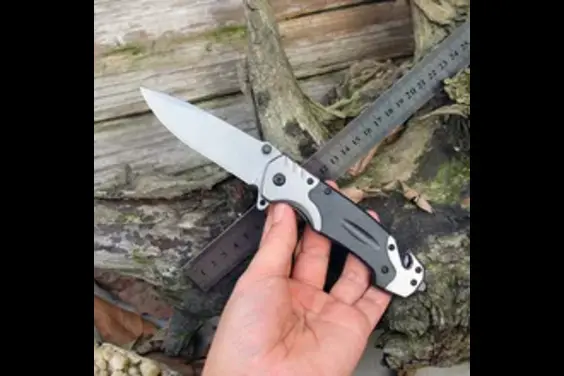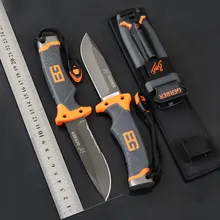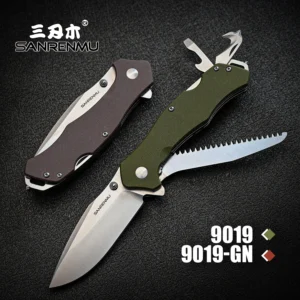Survival situations demand preparedness, and one of the most crucial tools in your survival kit is a good knife. Whether you’re an outdoor enthusiast, a prepper, or just want to be ready for unexpected situations, having the right survival knife can be a game-changer. In this comprehensive guide, we will explore everything you need to know about choosing the best survival knife.
I. Why is a Good Knife Essential for Survival?
A reliable survival knife is more than just a tool; it’s a lifeline in challenging situations. Here are several reasons why having a good knife is essential for survival:
I.I. Cutting and Processing
A knife is your primary cutting tool in the wilderness. It can help you process wood for shelter, prepare food, and fashion tools or weapons.
I.II. Self-Defense
In emergencies, a knife can serve as a self-defense tool against wildlife or potential threats.
I.III. Versatility
A good survival knife is versatile, capable of performing various tasks, such as chopping, slicing, and carving.
I.IV. First Aid
It can be used for first aid, such as cutting bandages or removing splinters.
I.V. Fire-Making
Some survival knives come with features like firestarter rods, making it easier to start a fire for warmth and cooking.
II. Characteristics of a Good Survival Knife
Before diving into the specifics of choosing a survival knife, let’s discuss the essential characteristics to look for:
II.I. Blade Material
A good survival knife should have a strong, corrosion-resistant blade material. Stainless steel and high-carbon steel are popular choices. High-carbon steel offers excellent edge retention but requires more maintenance.
II.II. Blade Design
Look for a versatile blade design, such as a drop-point or clip-point blade. These designs are suitable for a wide range of tasks.
II.III. Full Tang
A full tang knife means the blade extends through the handle, providing strength and durability. Full tang knives are less likely to break under pressure.
II.IV. Blade Length
A blade length between 4 to 6 inches is generally recommended for survival knives. It’s long enough for various tasks but not too unwieldy.
II.V. Handle Material
Choose a handle material that offers a secure grip even when wet. Materials like rubber, micarta, or textured plastic are good options.
II.VI. Tang Construction
The tang construction should be solid and secure. Look for knives with a visible, exposed tang at the pommel for added strength.
III. Types of Survival Knives
Survival knives come in various types, each with its advantages and disadvantages. Let’s explore the most common types:
III.I. Fixed-Blade Knives
Fixed-blade knives are the most popular choice for survival. They are durable, reliable, and can handle heavy-duty tasks. They are typically stronger than folding knives and easier to clean.
III.II. Folding Knives
Folding knives are compact and portable. While not as robust as fixed-blade knives, they can still be effective for survival tasks. Look for folding knives with a lock mechanism for added safety.
III.III. Multi-Tool Knives
Some survival knives come with additional tools, such as screwdrivers, can openers, or saw blades. These can be useful but may sacrifice some blade size.
IV. How to Choose the Right Survival Knife
Now that you understand the essential characteristics and types of survival knives, here are steps to help you choose the right one:
IV.I. Determine Your Needs
Consider your specific needs. Are you primarily using the knife for camping, hiking, or as part of an emergency kit? Your intended use will influence your choice.
IV.II. Blade Material and Design
Select a blade material and design that aligns with your needs. High-carbon steel offers excellent durability and sharpness, but it requires more maintenance. A versatile design like a drop-point blade is a safe choice.
IV.III. Tang Construction
Choose a knife with a full tang construction for durability. This ensures that the blade extends through the handle, providing stability and strength.
IV.IV. Blade Length
Opt for a blade length between 4 to 6 inches, as it strikes a balance between versatility and manageability.
IV.V. Handle Comfort
Consider the handle material and ergonomics. A comfortable grip is essential, especially if you plan to use the knife for extended periods.
IV.VI. Sheath Quality
A quality sheath is crucial for safe storage and carrying. Look for a sheath made of durable materials that securely hold the knife.
V. Popular Survival Knife Brands
To help you get started in your search, here are some reputable survival knife brands known for their quality and reliability:
V.I. Gerber
Gerber is a well-respected brand known for producing a wide range of survival knives, from compact folding models to robust fixed-blade options.
V.II. Buck Knives
Buck Knives has a long history of crafting high-quality knives. Their knives often feature durable blade materials and comfortable handles.
V.III. ESEE Knives
ESEE Knives specializes in robust, no-nonsense survival knives with a strong following among outdoor enthusiasts and survivalists.
V.IV. Benchmade
Benchmade offers a variety of folding and fixed-blade knives, known for their precision engineering and durability.
VI. Caring for Your Survival Knife
A good survival knife is an investment, and proper care is essential to ensure its longevity. Here are some tips for maintaining your survival knife:
VI.I. Cleaning
After use, clean your knife thoroughly with warm, soapy water, and dry it completely. Avoid prolonged exposure to moisture, which can cause rust.
VI.II. Sharpening
Regularly sharpen your knife using a quality sharpening tool or stone. A sharp blade is safer and more efficient.
VI.III. Lubrication
Apply a small amount of oil to the blade and moving parts to prevent corrosion and ensure smooth operation.
VII. Frequently Asked Questions (FAQ)
VII.I. What is the best steel for a survival knife blade?
The choice of steel depends on your priorities. High-carbon steel offers excellent sharpness but requires more maintenance to prevent rust. Stainless steel is more corrosion-resistant but may require more frequent sharpening.
VII.II. Can I use a survival knife for cooking?
Yes, many survival knives can be used for cooking. However, ensure that the knife is clean and sanitized before using it for food preparation.
VII.III. Are tanto blades suitable for survival knives?
Tanto blades have a distinct shape with a reinforced tip. While they are excellent for piercing, they may not be as versatile for general survival tasks compared to drop-point or clip-point blades.
VII.IV. Can I replace the handle of my survival knife?
In some cases, you can replace the handle of a survival knife if it’s removable. However, it’s essential to ensure that the replacement handle is secure and comfortable to grip.
VII.V. How often should I oil my survival knife?
The frequency of oiling your survival knife depends on usage and storage conditions. Check the knife regularly, and apply a light coat of oil when you notice any signs of rust or dryness.
VIII. Conclusion
In the world of survival, a good knife is not just a tool; it’s a companion that can make the difference between thriving and struggling. Understanding the essential characteristics, types, and how to choose the right survival knife for your needs is a crucial step toward preparedness. Whether you’re exploring the great outdoors or preparing for unforeseen emergencies, a well-selected survival knife will always have your back. It’s more than just a blade; it’s your lifeline in the wild.





